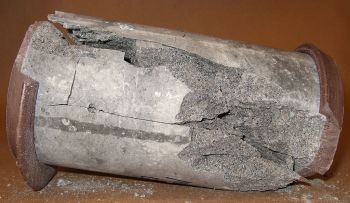Material Properties: Difference between revisions
Rmanwaring (talk | contribs) (Created page with "<!-- Delete any sections that are not necessary to your topic. Add pictures/sections as needed --> __NOTOC__ ---- {{Picture <!-- Add image file name (ex.image.jpg) --> |image= FailedConcreteCylinder.jpg <!--Add link if applicable --> |link= <!-- Add picture caption --> |caption= Failed Concrete Cylinder }} <!-- Introductory paragraph or topic page summary --> As a result of the large costs associated with constructing and maintaining a dam, dams often have lon...") |
Rmanwaring (talk | contribs) No edit summary |
||
| Line 12: | Line 12: | ||
<!-- Introductory paragraph or topic page summary --> | <!-- Introductory paragraph or topic page summary --> | ||
As a result of the large costs associated with constructing and maintaining a dam, dams often have long design lives upwards of 100 years (the average age of dams in the United States is 60 years old).<ref name="NID_USACE">National Inventory of Dams (USACE), 2022</ref> Additionally, many components of a dam are completely inundated for a large portion of their design lives and are often difficult or even impossible to inspect and/or replace while the dam is in [[operation]]. As a result, the materials used to construct the dam must be able to maintain their strength and resist degradation through weathering and corrosion. Additionally, the high risks associated with a failure of many high-[[Hazard Potential|hazard potential]] dams result in the need for thorough testing, analysis, and quality control of both production and installation of the proposed materials, which are all essential to the safety and longevity of the dam as a whole structure. | As a result of the large costs associated with constructing and maintaining a dam, dams often have long design lives upwards of 100 years (the average age of dams in the United States is 60 years old).<ref name="NID_USACE">National Inventory of Dams (USACE), 2022</ref> Additionally, many components of a dam are completely inundated for a large portion of their design lives and are often difficult or even impossible to inspect and/or replace while the dam is in [[operation]]. As a result, the materials used to construct the dam must be able to maintain their strength and resist degradation through weathering and corrosion. Additionally, the high risks associated with a failure of many high-[[Hazard Potential | hazard potential]] dams result in the need for thorough testing, analysis, and quality control of both production and installation of the proposed materials, which are all essential to the safety and longevity of the dam as a whole structure. Materials used in the [[construction]] of dams include "earth, rock, tailings from mining or milling, concrete, masonry, steel, timber, miscellaneous materials (such as plastic or rubber) and any combination of these materials."<ref name="ASDSO">ASDSO, 2022</ref> | ||
==[[Best Practices Resources]]== | ==[[Best Practices Resources]]== | ||
Revision as of 23:41, 14 November 2022

|
| Failed Concrete Cylinder |
As a result of the large costs associated with constructing and maintaining a dam, dams often have long design lives upwards of 100 years (the average age of dams in the United States is 60 years old).[1] Additionally, many components of a dam are completely inundated for a large portion of their design lives and are often difficult or even impossible to inspect and/or replace while the dam is in operation. As a result, the materials used to construct the dam must be able to maintain their strength and resist degradation through weathering and corrosion. Additionally, the high risks associated with a failure of many high- hazard potential dams result in the need for thorough testing, analysis, and quality control of both production and installation of the proposed materials, which are all essential to the safety and longevity of the dam as a whole structure. Materials used in the construction of dams include "earth, rock, tailings from mining or milling, concrete, masonry, steel, timber, miscellaneous materials (such as plastic or rubber) and any combination of these materials."[2]
Best Practices Resources
![]() Lubricants and Hydraulic Fluids (EM 1110-2-1424), USACE, 2016
Lubricants and Hydraulic Fluids (EM 1110-2-1424), USACE, 2016
![]() Design of Hydraulic Steel Structures (ETL 1110-2-584), USACE, 2014
Design of Hydraulic Steel Structures (ETL 1110-2-584), USACE, 2014
![]() Concrete Manual: Part 2, USBR, 1992
Concrete Manual: Part 2, USBR, 1992
![]() Concrete Manual: Part 1, USBR, 1988
Concrete Manual: Part 1, USBR, 1988
Citations:
Revision ID: 4155
Revision Date: 11/14/2022
